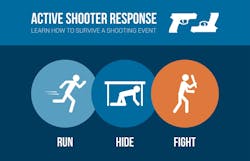The recent terror attacks in Paris and San Bernardino have once again demonstrated the devastating consequences that can result from an active shooter event. Aside from galvanizing world leaders to come together in their efforts to dismantle ISIS, these incidents have also spurred security industry professionals to take a closer look at the things organizations of all shapes and sizes can do to mitigate loss of life in the future. Just last week, ASIS International and the National Fire Protection Association announced that they have launched a joint initiative aimed at addressing active shooter incidents.
A kick-off stakeholder meeting for the initiative scheduled to take place next month in Arlington, Va. is expected to bring together more than 50 standards developers, industry groups, and members of law enforcement, government and academia to examine administrative, management and technology issues related to active shooter events.
According to Dr. Marc Siegel, commissioner of the ASIS Global Standards Initiative, one of the primary goals of the joint effort is to develop some practical guidance that any organization could use in their facilities.
“In a lot of these incidents, the key to survival is buying time, so we will talk about different tactics and how to get people to avoid misidentifications and collateral damage when the police arrive, as well as thinking about when to shelter in place or evacuate,” said Siegel. “Part of the real power and beauty of this collaboration between NFPA and ASIS is that you have things that you would do for fire and not security and vice versa. I think by getting the two groups together and starting to discuss some of the issues, it will make it a lot easier to try to figure how you deal with some of these conflicts between what would be good fire and life safety practice and what would be considered good security practice.”
A good example of one of the conflicts that can arise between these two domains is the evacuation of a building during a fire alarm. While people have been trained to get out of a building as quickly and efficiently as possible in the event of a fire alarm, there is always the danger that someone could set off the alarm as part of an effort to draw everyone outside to be shot.
This fear became a reality in the late 1990s in the shooting massacre at Westside Middle School near Jonesboro, Ark. that claimed the lives of five people and resulted in another 10 being wounded. The plot was carried out by two young boys, one of whom pulled the school’s fire alarm while the other carried a cache of firearms to some woods just outside the school. The boys opened fire on students and teachers as they exited the building. This is why Siegel believes it’s vitally important to have the involvement of both ASIS and the NFPA in this initiative as members of both organizations will have to work together to solve these types of concerns moving forward.
“Security, fire protection, and life safety communities need to develop a coordinated effort to address these low probability-high consequence events in our society,” said Robert Solomon, division manager, Building Fire Protection, NFPA. “By implementing the best technology, architectural, and management strategies, we can strengthen our defenses and resilience against active shooters. Given the short response time to active shooter incidents, people need the technology and training to buy time essential to survival, and to minimize losses and consequences of an attack.”
Siegel also sees this initiative as an opportunity to really figure out what can feasibly be done to guard against active shooters as opposed to having a lot of unrealistic proposals put forth that could never be fully implemented by most institutions.
“A lot of people look at (active shooters) like fire protection where you could have an easy technology solution and I don’t think many security people would really lean in that direction,” he said. “Do you really want to start requiring people to invest in all kinds of changes to buildings, doors and things like that when some administrative, drill-type activities or management approaches might actually give you more cost-effective results? Everybody points to the schools that they need to do this and that and I’ve sat in meetings that go from, essentially, schools have to completely reconfigure themselves architecturally to really extensive things that I couldn’t picture somebody in a school doing.”
Despite the unpredictable nature of active shooter events, Siegel said there are some universal things people can do to prepare in case they ever do encounter a gunman. For example, if an organization has been conducting drills with its personnel, they can train them to have floor plan and emergency contact information at the ready, as well as know whether or not they should run, hide or fight based on how the situation unfolds.
“When people are evacuating, have you designated safe locations at various assembly points?” asked Siegel. “If the police are coming, how do you identify yourself to the police and how do you hand off the situation with the police? Do you do training to give people a better idea of what they should try to be aware of to better brief first responders when they arrive at the scene? How do you communicate with people involved in the incident and with family members and what kinds of information should you share? There are a lot of things that are common and would apply to a wide range of different situations that you can include in a document. With those types of procedures and administrative things you can do a lot that would be more or less generic to lots of different scenarios.”
Although K-12 schools and higher education campuses will obviously be a heavy focus of the initiative, Siegel said they plan to invite people from a broad range of vertical markets to take part in these conversations, including entertainment, sporting venues, houses of worship, and office environments among others. At the kick-off meeting in January, Siegel said they will decide whether or not they want to move forward with writing a whitepaper on the subject or developing some type of guidance standard. Siegel said he doubts they would proceed with any type of requirement standard on the issue.
Organizations interested in attending the January 19, 2016 meeting should contact [email protected].


